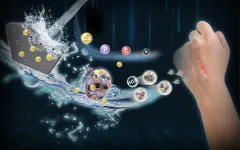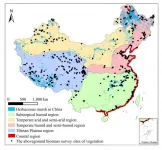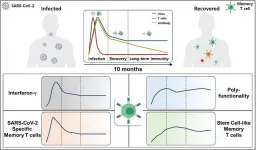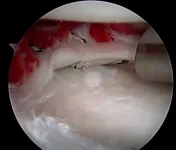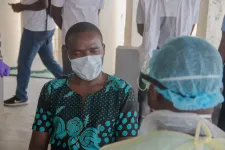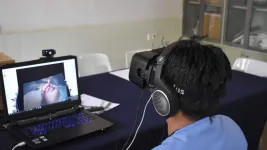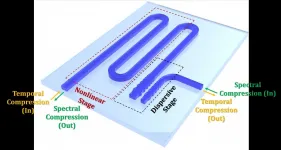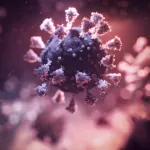(Press-News.org) Recently, with the help of a steady-state strong magnetic field experimental device, scientists constructed nano-scale borate bioactive glass (Nano-HCA@BG), which can effectively reduce the biological toxicity of borate bioglass, improve the biocompatibility of the glass, and promote the effect of borate bioglass on skin repair.
Prof. WANG Junfeng from the Hefei Institutes of Physical Science (HFIPS) of the Chinese Academy of Sciences (CAS), collaborating with Prof. ZHANG Teng from Fuzhou University in this study, said, "it is expected to become the next generation of skin wound repair dressings." Related research was published in Chemical Engineering Journal.
Borate bioglass is a glass with boron element (B) as the glass network matrix. With good dopability and degradability, it has great potential in the field of skin tissue repair. However, It releases a large amount of alkaline ions, and the explosive release of these ions will change the acid-base environment of the tissue around the glass material, thereby inhibiting cell proliferation.
In addition, the effective surface area of micron-sized borate bioglass in contact with tissues at the wound is small, and the ions on the glass surface are not conducive to the deposition of collagen, so scars are easily formed at the wound after healing. Therefore, preparing a nano-scale borate bioglass with no biological toxicity and excellent biological performance is an urgent problem to be solved.
In this study, the researchers used a special mobile phase, for the first time, to pre-treat micron-sized borate bioglass by melting method in vitro. They obtained Nano-scale (~50nm) borate bioglass (Nano-HCA@BG), which was covered with an amorphous hydroxyapatite (HCA) layer.
During the processing, the ions (PO43- and CO32-) in the mobile phase were deposited on the surface of the glass to form the HCA layer, which effectively inhibited the rapid release of boron and calcium in the remaining glass and thereby reduced the biological toxicity of the glass itself to cells.
In addition, HCA, as an important inorganic component in bones, has good biocompatibility, and can accelerate the induction of collagen synthesis in tissues.
The results of in vitro degradation experiments, cell experiments, and animal experiments showed that compared with the existing commercialized bioactive glass, HCA and micron-sized borate bioglass, nano-HCA@BG slow-released boron calcium, and other elements can effectively accelerate wound cells migration and further up-regulation of the expression of vascular-related growth factors in the wound.
Besides, the amorphous HCA layer on the surface of the glass not only reduces the rapid release of the glass, but also promotes the deposition of collagen in the wound, which in turn promotes the healing of the wound more quickly.
INFORMATION:
This research was supported by the National Natural Science Foundation of China and a major project of the Ministry of Science and Technology.
Sleep deprivation - from lifestyle choices, pandemic stress, or late-night computer study - can quickly lead to loss of energy and function during the day and even feelings of anger and depression, an Australian sleep institute study has shown.
The study, led by Flinders University, asked 34 health teenagers (20 males) aged between 15 and 17 to spent 10 days and nine nights in a specially designed sleep centre.
They were allocated to one of three sleep 'doses' for five consecutive nights- from five hours, 7.5 hours, or 10 hours in bed per night - with two baseline and two 'recovery' nights of up to 10 hours' time in bed.
Their mood was measured every three hours after waking up to assess responses to feelings such as 'depressed', 'afraid', 'angry', 'confused', ...
Wetland, forest, and ocean are the three largest ecosystems in the world. Although the area of wetland ecosystem accounts for only 4-6% of the total land area, the carbon reserves of wetland ecosystem accounts for 12-24% of the global land carbon reserves. Under the background of global climate change, the research on carbon sequestration of wetland has become an important subject of global carbon cycle research.
The area of marshes in China ranks third in the world, and herbaceous marsh is the most widely distributed among all the types of marshes. As an important quality parameter of marsh ecosystem, aboveground biomass of vegetation is a crucial index estimating the carbon storage of marsh vegetation, and the basis for studying ...
A KAIST immunology research team found that most convalescent patients of COVID-19 develop and maintain T cell memory for over 10 months regardless of the severity of their symptoms. In addition, memory T cells proliferate rapidly after encountering their cognate antigen and accomplish their multifunctional roles. This study provides new insights for effective vaccine strategies against COVID-19, considering the self-renewal capacity and multipotency of memory T cells.
COVID-19 is a disease caused by severe acute respiratory syndrome coronavirus-2 (SARS-CoV-2) infection. When patients recover from COVID-19, SARS-CoV-2-specific adaptive immune memory is developed. The adaptive immune system consists ...
While this isn't the fountain of youth, scientists may have improved healing in our joints - even in areas that become weaker as we grow older. The meniscus is a durable, yet flexible tissue found in joints like our wrist and knees that helps them absorb shock during movement. Occasionally tears can occur in the meniscus due an awkward movement or structural weakness from old age. When we are young, there is plenty of blood flowing to this area allowing for quick healing, but as we get older, the meniscus receives less and less blood - with the inner most area becoming ...
An international team including Lancaster University researchers has created a strategy for understanding the evolution of the COVID-19 pandemic throughout the African continent.
Their COVID-19 surveillance strategy will improve the ability of African countries to interpret the complex data available to them during the pandemic.
Professor Peter Diggle, Dr Chris Jewell and Dr Claudio Fronterre from the Centre for Health Informatics, Computing and Statistics (CHICAS) at Lancaster Medical School worked with colleagues in the USA, Uganda and Switzerland to create a data-driven disease surveillance framework to track and predict ...
Cleft lip and palate is one of the most common congenital malformations. Its causes are mainly genetic. However, it is still largely unknown exactly which genes are affected. A new international study led by the University of Bonn now provides new insights. The results are published in the journal Human Genetics and Genomics Advances, but are already available online.
The researchers from the Institute of Human Genetics at the University Hospital Bonn combined various data sources in their work. In the course of their research, they discovered five new regions in the human genome in which variations in the DNA sequence are associated with an ...
A new report that could help improve how immersive technologies such as Virtual Reality (VR) and Augmented Reality (AR) are used in healthcare education and training has been published with significant input from the University of Huddersfield.
Professor David Peebles, Director of the University's Centre for Cognition and Neuroscience, and Huddersfield PhD graduate Matthew Pears contributed to the report - 'Immersive technologies in healthcare training and education: Three principles for progress' - recently published by the University of Leeds with input from range of academics, technologists and health professionals.
The principles have also been expanded upon in a letter to the prestigious journal BMJ ...
A train carrying cargo has finite space. The amount of cargo that can be carried onboard is limited by the size of the cargo and the capacity of the train. Analogously, the amount of time taken up by an optical signal limits the amount of data that can be carried. Temporally shorter signals allow more data to be squeezed into a given time duration, in a method called optical time division multiplexing. Photonics researchers have recently succeeded in squeezing light in time by 11 times. The developed temporal compression system allows an equivalent increase in the number of bits transmitted by light ...
A new international study has found that the key properties of the spikes of SARS-CoV-2 virus which causes COVID-19 are consistent with those of several laboratory-developed protein spikes, designed to mimic the infectious virus.
A central component in designing serological tests and vaccines to protect against COVID-19 is the manufacture of protein "spikes". These recombinant spikes closely mimic those sticking out of surface of the infectious virus and trigger the body's immune system into action.
Laboratory manufactured spikes are also used for serological testing (also referred to as antibody testing) and as research reagents. The findings show how that viral spike manufactured through different methods in laboratories across the globe ...
Since July 2020, remdesivir has been conditionally approved in Europe for the treatment of coronavirus disease (COVID-19) in adults and adolescents aged 12 years and older with pneumonia who require supplemental oxygen but no invasive ventilation. In an early benefit assessment, the German Institute for Quality and Efficiency in Health Care (IQWiG) has now investigated whether the drug, which was originally developed for the treatment of Ebola virus disease, offers these patients an added benefit compared to the appropriate comparator therapy (here: therapy according to physician's choice).
This investigation yielded an indication of a considerable added benefit of remdesivir compared to the appropriate comparator therapy for adults with pneumonia ...
